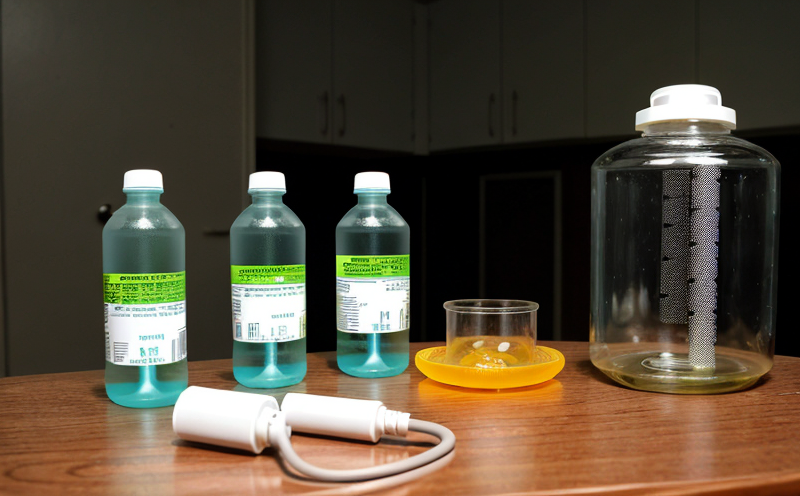ISO 9698 Tritium Activity Test in Water
The ISO 9698 method is a standardized protocol used to measure tritium activity levels in water samples. This method provides a reliable and accurate way for laboratories to quantify the radioactivity of tritium, which can be critical for ensuring compliance with environmental regulations.
Tritium, also known as hydrogen-3, is a radioactive isotope that occurs naturally in the environment due to cosmic rays interacting with atmospheric nitrogen. It can also enter the water cycle through nuclear reactions or industrial processes. The presence of tritium in water sources needs careful monitoring because it can pose health risks if not controlled properly.
The ISO 9698 test is particularly relevant for sectors such as environmental protection, wastewater treatment facilities, and nuclear power plants. In these contexts, understanding the levels of tritium activity helps identify potential hazards and inform appropriate remediation measures.
The testing process involves collecting water samples from various points along a water supply chain. These samples are then prepared according to standard procedures before being analyzed using specialized instrumentation capable of detecting even minute quantities of tritium. The results provide critical data that can be used for regulatory compliance, risk assessment, and public safety.
The accuracy and precision of the ISO 9698 method make it an essential tool in environmental monitoring programs. By ensuring consistent and reliable measurements across different locations and over time, this test helps maintain high standards of water quality control.
Understanding the nuances of the ISO 9698 protocol is crucial for those involved in quality management, compliance oversight, or research and development within industries related to water testing. Familiarity with these methods enables stakeholders to make informed decisions regarding resource allocation, operational adjustments, and strategic planning aimed at enhancing overall performance.
The importance of accurate tritium measurement cannot be overstated given its role as an indicator for broader environmental health issues. Regular monitoring ensures early detection of problems that could otherwise lead to severe consequences. Thus, proficiency in performing this test is not just beneficial but imperative for maintaining safe and sustainable water resources.
Applied Standards
| Standard | Description |
|---|---|
| ISO 9698:1995 | This standard specifies the procedure for determining tritium content in water samples using liquid scintillation counting. It ensures that measurements are consistent and reproducible. |
| ASTM D7426-06(2013) | An American Society for Testing and Materials standard that describes the procedure for measuring tritium in water by beta spectrometry. This method complements ISO 9698 by offering alternative techniques. |
| EN 14579:2003 | An European Standard providing guidelines on how to perform gamma spectrometric analysis of tritium in water samples. It supports laboratories seeking accreditation under EU directives. |
| IEC 62893-2:2017 | This international standard defines the requirements for calibrating radiation detection instruments used in tritium measurement, ensuring accurate and traceable results. |
Industry Applications
The ISO 9698 Tritium Activity Test finds extensive application across diverse industries where water quality is paramount. For instance, in the environmental protection sector, it aids in tracking tritium levels following accidental releases into aquatic systems. This information supports efforts to mitigate pollution and restore affected ecosystems.
Wastewater treatment plants benefit significantly from this testing as they can monitor incoming raw sewage for tritium contamination before processing begins. By identifying high-risk batches early on, operators can implement targeted treatments more effectively, reducing downstream impacts while minimizing costs associated with extended processing times.
Nuclear power plants also rely heavily on accurate tritium measurements during decommissioning processes to ensure residual levels comply with stringent discharge limits set forth by regulatory bodies like the International Atomic Energy Agency (IAEA).
In addition to these established applications, advances in analytical techniques continue to expand the scope of ISO 9698 usage into new areas such as groundwater protection and aquifer recharge projects. As technology evolves, so too does our capability to safeguard precious freshwater resources against radioactive contamination.
Competitive Advantage and Market Impact
Laboratories specializing in ISO 9698 Tritium Activity Tests enjoy several strategic advantages that contribute positively to their market position:
- Regulatory Compliance: Adherence to international standards like ISO 9698 ensures compliance with local and global regulatory frameworks, enhancing credibility among clients.
- Innovation Leadership: Mastery over cutting-edge methods fosters innovation within the laboratory, setting benchmarks for quality assurance practices globally.
- Client Trust: Consistently accurate results build trust between service providers and their customers, fostering long-term relationships based on reliability.
The demand for precise tritium measurements is expected to grow further as awareness about nuclear safety increases. This presents a significant opportunity for laboratories offering advanced testing services. By staying at the forefront of technological developments, these entities can secure competitive advantages and drive market growth.
Moreover, investing in specialized equipment and personnel trained specifically in ISO 9698 procedures positions companies to meet increasingly stringent requirements set by governing agencies worldwide. This proactive approach not only meets current needs but also anticipates future challenges, ensuring sustained success in the industry.





